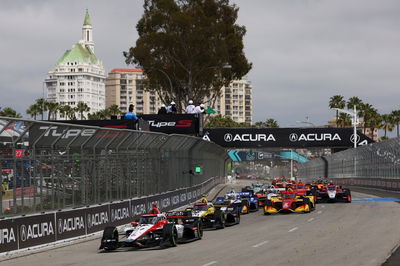Indy construction gets underway on Gold Coast.
The construction of one of the finest motor racing street circuits in the world takes only 96 days on Australia's bustling Gold Coast.
Wednesday 18th August marks the start of construction of the Lexmark Indy 300 circuit, as the countdown continues towards the October 21 to 24 Event.
Over the next 66 days, bridges will be erected, concrete barriers installed, grandstands built, corporate suites furnished, fencing secured, many more temporary structures fitted, and large-scale power and telecommunications systems activated.
The construction of one of the finest motor racing street circuits in the world takes only 96 days on Australia's bustling Gold Coast.
Wednesday 18th August marks the start of construction of the Lexmark Indy 300 circuit, as the countdown continues towards the October 21 to 24 Event.
Over the next 66 days, bridges will be erected, concrete barriers installed, grandstands built, corporate suites furnished, fencing secured, many more temporary structures fitted, and large-scale power and telecommunications systems activated.
All pieces of the puzzle will be complete by October 21 for the four days of the Lexmark Indy 300, and then dismantled over 26 days in one of the largest human resource undertakings in Australia each year.
The construction of the Lexmark Indy 300 circuit has been streamlined to 96 days, a massive reduction from the 199 days it took in 1996 - a remarkable achievement considering the inventory infrastructure is three times more than 1991 and construction work is restricted to certain hours of the day by local authorities.
The installation of the pedestrian bridge at the northern end of the circuit near MacIntosh Island has annually marked the start of construction and the tradition continued in the early hours of this morning.
Lexmark Indy 300 General Manager James O'Brien said the construction of the Gold Coast circuit has been acclaimed internationally and is used as a benchmark for new temporary street circuits world-wide.
"It is a significant achievement to convert a thriving and bustling commercial and recreational district into a motor racing circuit, able to facilitate more than 300,000 people and high-speed motor racing action.
"This major undertaking involves cooperation and support from State Government, Gold Coast City Council, other State and Local Authorities, hundreds of contractors, residents and commuters.
"Over the 14 years of the Event, we have streamlined the construction process into a slick operation with very few disruptions to Gold Coast residents and commuters. Some disturbance is unavoidable but we are always striving to keep this to a minimum."
Mr O'Brien said, while there has been little change to the construction plans, there has been a commitment to increasing the double height debris fencing.
"The Lexmark Indy 300 street circuit is an international leader in motor racing safety standards, and one of the major advancements over the past few years has been an increase in double height debris fencing," said O'Brien.
"This year there will be 330 panels of double height debris fencing strategically positioned around the circuit, a significant increase since 1994 when they were introduced to the Event.
"Our endeavours to increase the double height debris fencing have been applauded by CAMS (Confederation of Australian Motorsport) and the FIA (the international governing body of motorsport)."
Gold Coast based engineering company Weathered Howe has overseen the extensive building procedure since the first Event in 1991, annually reviewing, modifying and improving the plans to position the Lexmark Indy 300 as a world-leading circuit.
To facilitate the construction of the circuit, a traffic initiative introduced in 1999 will continue this year to reduce traffic delays. Two traffic lanes will remain open on the Gold Coast Highway at all times with the speed limit on the southbound side reduced from 70km/h to 50km/h during the construction process.










